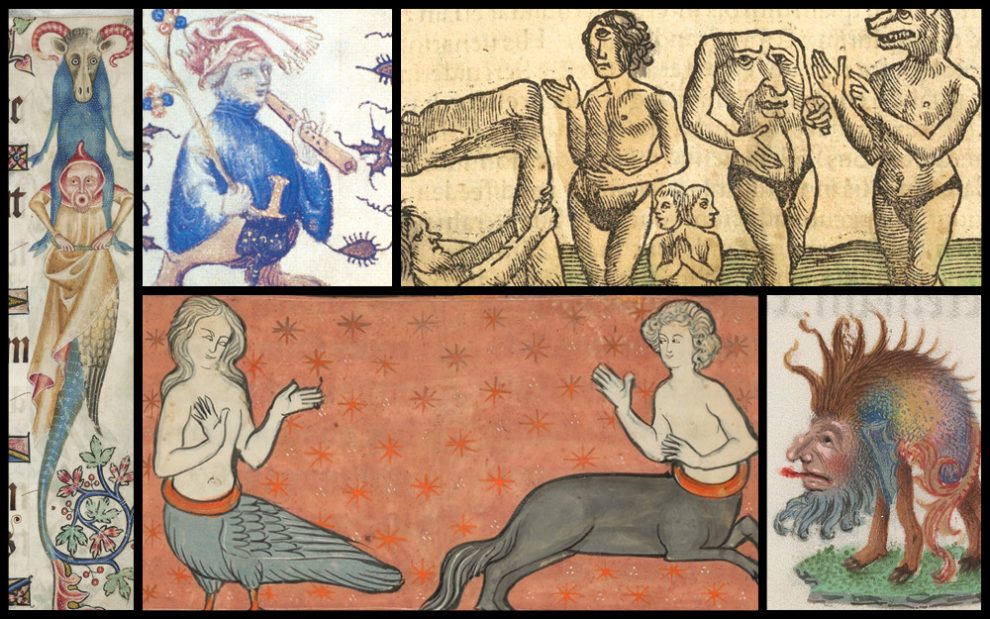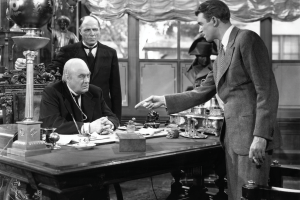Strange little beasts inhabit the margins of medieval manuscripts. In the famous Luttrell Psalter, a man-bird hybrid grabs a floral border as his bird half pecks his torso; a two-legged beast with the head of a boar, the body of a fish, and a leafy tail stalks the bottom margins; a creature with two blue human heads and scarlet animal legs discusses matters; and below them a long pastel pink rabbit sticks out its tongue and stretches its human-like legs. Creatures like these populate manuscripts from across medieval Europe.
Before the invention of the printing press, every book had to be handwritten, and some books included illustrations. Those with gold leaf on the parchment were known as illuminated manuscripts. While all books were expensive to make, illustrated and illuminated manuscripts were particularly costly. Initially, only wealthy people and institutions such as monasteries and big churches could afford them. Such manuscripts are where you find those odd, elaborate creatures.
Technical names for the creatures include grotesques, drolleries, babewyns (from the Italian word for “baboon”), and hybrids.
The term grotesque was first used during the Renaissance period to describe the monstrous creatures on the frescoes in the first-century Emperor Nero’s palace, Domus Aurea; grotesque came from grotto, since these frescoes were discovered in caves. During the 19th century’s Gothic Revival, grotesques became the accepted way to refer to these creatures in medieval art, and today, grotesque refers specifically to the monsters found in medieval art, including cathedral stonework and manuscript margins. The style of these grotesques, however, can vary depending on the time period.
Up until the early Middle Ages, people usually read out loud, and reading was often a group activity. In his book Image on the Edge (Reaktion Books), Michael Camille says that when people started thinking of text as a written document instead of a prompt for speech, page margins became a place for art. Creatures were interlaced between letters and words.
In her book, Images in the Margins of Gothic Manuscripts (University of California Press), Lilian M. C. Randall says that in the latter half of the 13th century, both secular and religious manuscripts had more elaborate marginalia. More laypeople were able to buy books, so more secular workshops opened, meaning bookmaking was no longer the domain of monks and nuns. Often, men and women worked as scribes and illuminators as a family business. The 14th-century married couple Richart and Jeanne de Montbaston transcribed and illuminated books in Paris. As more secular people started illustrating books, grotesques became more lighthearted and comical.
Inspiration for grotesques came from many places, including but not limited to ancient texts, mythology, scripture, medieval fabliaux, exempla, fables, oral folklore, and the artist’s imagination. Some grotesques resulted from artists trying to draw animals they had never seen but had heard described, such as elephants and lions, while others were purely mythological creatures. According to medieval codicologist Evan Pridmore, margins’ size constraints meant artists didn’t have to worry about realism and could have fun with their artwork. (I paint with watercolors, and I can confirm that when I paint smaller pieces, realism becomes less of a priority.)
Many types of monsters decorate medieval manuscripts. The typical ones were known as the “Plinian races,” because Pliny the Elder had written about them in his Natural History. These include (but are not limited to) giants, one-footed sciopods, dog-headed men called cynocephali, men with faces on their chests known as blemmyae, and giant-eared panotii. Many Europeans believed these beings lived in far-off places like India or Ethiopia. In Of Sirens and Centaurs: Medieval Sculpture in Exeter Cathedral (Impress Books), Alex Woodcock says extremes of form were linked with extremes of place. This mythology around fabulous beasts was often intertwined with a dehumanization of people considered other and exotic.
Other monsters, such as dragons and wyverns, often symbolized the devil. The belief that beauty equals good and ugliness equals evil added a layer of morality to monster portrayals. In medieval exempla (stories told in sermons), however, Satan often disguised himself as beautiful to seduce people into sin—an idea both based on and undercutting the prejudice that beauty must equate with goodness.
When it comes to some of the more unusual grotesques, such as bizarre plant-animal-human hybrids, their symbolic meanings are murkier. Medieval culture was fascinated with otherness, so grotesques often represented the liminal spaces between familiar entities. This fascination may partially reflect the animal-headed masks worn by mummers—that is, actors in traditional dramatic performances. Others, such as human-headed animals with floral tails, are not so easily explained.
While some grotesques have an allegorical, theological significance, recent scholarship also looks at the play of semiotics between the written text and pictorial images. In Monsters and Grotesques in Medieval Manuscripts (University of Toronto Press), Alixe Bovey notes that while grotesques were designed for their humor and shock value, artists had “earnest intentions” too. Michael Camille says grotesques could be visual word plays. For instance, in the Baltimore Hours, one grotesque has a human body and a bird’s neck and head— possibly a pun on the psalm above the figure reading Inpinguasti in oleo caput mean (“You have anointed my head in oil”). In Latin, in oleo means “with oil,” but since “bird” in Old French is oisel this could be a stealthy pun: “You have anointed my head with a bird.”
In one 14th-century French Book of Hours, grotesques parody the main illumination of monks praying the Office of the Dead. In the folio’s middle, three monks with books sing over a coffin, while in the margins monkeys, grylluses (figures with a head on two legs), a skeleton, a bird with a giant beak, and two other monks (one very short) carry books or shovels. By parodying a holy office, this series of images demonstrates the medieval flexibility about juxtaposing the sacred with the profane. The meaning of the sacred words of scripture, this juxtaposition implies, is present not only in the lives of monks and other religious but in all creation, even the seemingly strange or vulgar.
As Woodcock writes, “grotesques defy reason and accepted norms” while also creating a “threshold between human and divine.” In the Middle Ages, social norms were widely considered to be God-given. Grotesques, in subverting these norms, questioned this assumption, just as many medieval mystics and reformers did, implying that paths to God exist outside the approved and accepted channels.
Images of grotesques participating in the holy office and interacting with the text remind the viewer that despite these creatures’ otherness, they are still part of the elaborate tapestry of God’s creation. Grotesques and monsters, even though they break humanity’s norms, are beloved by God. So a deeper moral drawn from these illustrations points to the community of all creatures and the necessity of building bridges between different cultures and peoples.
Grotesques affirm that even in our otherness, we are also the same. While the Plinian races and other grotesques are depicted as monstrous, they are also shown taking care of their children, talking with one another, and living full and active lives. And since what is normal in one culture may be strange and bizarre to others, perhaps the Plinian races and grotesques would consider humans the monstrous ones.
At the same time that grotesques imply the commonality of all life, they are also reminders of some of the medieval prejudices that endure into the modern era. These illustrations, amusing though they are, were often based on false conceptions of different peoples, cultures, and species; they warn us of the danger that still lies in believing rumors or popular myths regarding peoples and cultures that seem foreign or exotic.
Ultimately, these strange, ornate, impossible little beings challenge us. How will we respond to these creatures that look different from ourselves? With anger and fear? Or with affection and fascination? Can we love the whole of our diverse cosmos, the way its Creator does?
This article also appears in the August 2025 issue of U.S. Catholic (Vol. 90, No. 8, pages 23-25). Click here to subscribe to the magazine.












Add comment